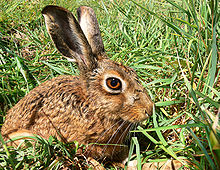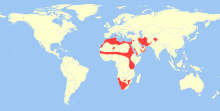Lepus capensis
| Cape hare | |
|---|---|
 |
|
| Scientific classification | |
| Kingdom: | Animalia |
| Phylum: | Chordata |
| Class: | Mammalia |
| Order: | Lagomorpha |
| Family: | Leporidae |
| Genus: | Lepus |
| Species: | L. capensis |
| Binomial name | |
|
Lepus capensis Linnaeus, 1758 |
|
 |
|
| Geographic range | |
The Cape hare (Lepus capensis), also called desert hare is a hare native to Africa and Arabia extending into India.
The Cape Hare is a typical hare, with well-developed legs for leaping and running, and large eyes and ears to look out for threats from its environment. There is usually a white ring around the eye. It has a fine, soft coat which varies in colour from light brown to reddish to sandy grey. Unusually among mammals, the female is larger than the male; this phenomenon is called sexual dimorphism.
It inhabits macchia-type vegetation, grassland, bushveld, and semi-desert areas.
The Cape Hare is a nocturnal herbivore, feeding on grass and various shrubs. Coprophagy, the consumption of an organism's own fecal material to double the amount of time food spends in the digestive tract, is a common behaviour amongst rabbits and hares. This habit allows the animal to extract the maximum nourishment from its diet, and microbes present in the pellets also provide nutrients.
Like other hares, they run fast. The only predator which is capable of outrunning them is the cheetah. All other predators are ambush and/or opportunistic hunters; examples of these are leopards, caracals, and black-backed jackals.
After a 42-day-long pregnancy, the female gives birth to from one to three young, termed , per litter and may have as many as 4 litters per year. A characteristic of hares which differentiates them from rabbits is that the young are born precocial; that is, the young are born with eyes open and are able to move about shortly after birth. The Cape Hare is no exception in this regard.
Cape Hare (Lepus capensis arabicus) photographed at Watba Camel Race Track, Abu Dhabi, United Arab Emirates
...
Wikipedia

